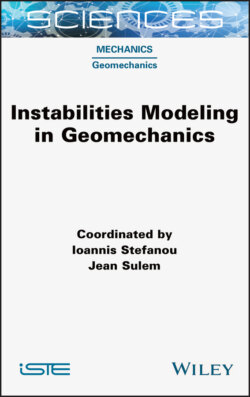Читать книгу Instabilities Modeling in Geomechanics - Jean Sulem - Страница 2
Table of Contents
Оглавление1 Cover
5 1 Multiphysics Role in Instabilities in Geomaterials: a Review 1.1. Introduction 1.2. General remarks 1.3. Solid phase material criteria 1.4. Material sample stability: experimental 1.5. Boundary value problems: uniqueness and stability at the field scale 1.6. Conclusion 1.7. References
6 2 Fundamentals of Bifurcation Theory and Stability Analysis 2.1. Introduction 2.2. Bifurcation and stability of dynamical systems 2.3. Stability of two-dimensional linear dynamical systems 2.4. Common types of bifurcations 2.5. From ODEs to PDEs 2.6. Summary 2.7. Appendix 2.8. References
7 3 Material Instability and Strain Localization Analysis 3.1. Introduction 3.2. Shear band model 3.3. Shear band formation in element tests on rock 3.4. Strain localization in fluid-saturated porous media 3.5. Conclusion 3.6. References
8 4 Experimental Investigation of the Emergence of Strain Localization in Geomaterials 4.1. Introduction 4.2. Methods 4.3. Selected materials 4.4. Strain localization in sands 4.5. Strain localization in porous rocks 4.6. Conclusion 4.7. References
9 5 Numerical Modeling of Strain Localization 5.1. Introduction 5.2. Cosserat continuum 5.3. Gradient elastoplasticity 5.4. Conclusion 5.5. Acknowledgments 5.6. References
10 6 Numerical Modeling of Bifurcation: Applications to Borehole Stability, Multilayer Buckling and Rock Bursting 6.1. Introduction 6.2. Borehole stability 6.3. Folding of elastic media as a bifurcation problem 6.4. Axial splitting and spalling 6.5. Conclusion 6.6. Acknowledgments 6.7. References
11 7 Numerical Modeling of Multiphysics Couplings and Strain Localization 7.1. Introduction 7.2. Experimental evidences of strain localization 7.3. Regularization methods 7.4. Coupled local second gradient model for microstructure saturated media 7.5. Coupled local second gradient model for an unsaturated medium 7.6. Modeling of a gallery excavation 7.7. Conclusion 7.8. References
12 8 Multiphysics Couplings and Strain Localization in Geomaterials 8.1. Introduction 8.2. Thermo-chemo-chemical couplings and stability of shear zones 8.3. Dissolution weakening and compaction banding 8.4. Conclusion 8.5. References
13 9 On the Thermo-poro-mechanics of Chemically Active Faults 9.1. Introduction 9.2. Time-independent formation of shear zones from solid mechanics 9.3. Time-dependent evolution of shear zones 9.4. Postfailure evolution of a shear zone 9.5. Comparison to field observations 9.6. Application to ETS sequences 9.7. Discussion 9.8. Appendix: poro-chemical model 9.9. References
14 10 Analysis of Instabilities in Faults 10.1. Introduction 10.2. Description of the model 10.3. Bifurcation analysis 10.4. Numerical analysis 10.5. Conclusion 10.6. Bibliography
16 Index
